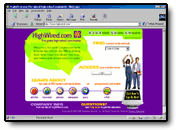|
Once your students have started writing, the next step might
be to give them a forum for their writing. One option is to send
their work to SNN for publication in our national online student
journalism network. But you may also want to create an online
student newspaper specifically for your school.
Here are some of the steps you can take to establish your
own school newspaper on the Web.
1. Creating the content
- You can start by looking at other online newspapers to determine
what you would like to include in your online publication. Check
out some of the daily newspapers
and student newspapers
listed in SNN's Links section.
The sections can include: News, Sports, Entertainment, Opinion,
Features, and Profiles but your editorial team may want to
add others like Letters to the Editor, Horoscopes or a Trivia
Quiz. Encourage your students to look through these sections
in your local daily newspaper or one of the others on the list
of links to get a sense of what kinds of stories appear in each
section.
- Once your group knows what sections they'd like to include
in their paper, assign the students to work as teams to coordinate
each section. One person may choose to be the section editor
-- that student will coordinate the activities of the other reporters
in that group and keep track of the stories that are planned
for the next issue of the newspaper.

|
- Each team can meet for a quick brainstorming session where
they come up with ideas for stories for their section. The stories
can focus specifically on your school and community or they can
include a look at the world outside. For example, stories from
the school could include changes to school policy that affect
the students, the success of one of the sports teams, the accomplishments
of a choir or theatre group at the school, a profile of a student
who's won an award, gone on an interesting trip or started a
project or business, or a fundraising drive to help a charity
or social group.
|
- Some students may see a story on the list that appeals to
them and may volunteer to do that one. Others may want a suggestion
from the section editor or the teacher. The goal is to make sure
everyone is involved in the production in some way -- whether
by doing an interview, writing a story, taking photos, writing
headlines, laying out the stories for online publication or editing
and proofreading the final copy.
- Allow each writer time to work on their story. Students can
get some advice on the reporting and writing process by visiting
the Getting
Started section of the Reporter's Toolbox.
- Encourage writers to find or create images to accompany their
stories. It could be a photo, a segment of video tape or a graphic.
Show them that the Web is a truly multimedia publishing forum
that can accommodate sounds, moving images and pictures!
2. Designing the online newspaper
Once your students have written their stories and collected
graphics to go with them, you will need to design the actual
pages of your online newspaper.
- There are many software packages that will help you design
a web page without knowing HTML code. They are known as
WYSIWYG editors, which stands for "What
you see is what you get". They are similar to the desktop
publishing programs that you can use to produce a print newspaper
or newsletter (programs like Adobe Pagemaker or Microsoft Publisher).
Some of the most popular web design programs include: Netscape
Composer (which is packaged with Netscape Communicator),
Adobe Page Mill and Microsoft
Frontpage. With these programs, you can create a front page
for your newspaper with links to your stories, lay out the stories
in a consistent format, insert graphics and photos, add headlines
and captions and create links to other sites.
- Once you've designed the actual pages, you need to publish
them on the Web by uploading your files to a web server.
Your school may have access to a web hosting server -- either
its own or through the school board or public library. If so,
you can simply upload the files to the school's server using
a FTP package (File Transfer Protocol). Ask your school's technology
specialist about using the server and uploading files.
- If you don't have access to a web hosting server, you could
try one of the free services that are available on the Web. They
include: YahooGeoCities,
Go.com or XOOM.COM
. You can design your newspaper on a program like Netscape Composer
and then upload the files to one of those servers. Or you can
use the simple design programs featured on those sites to create
your newspaper. Keep in mind that these sites offer you a free
service in exchange for the right to put advertising on your
page. You may want to check out their ads before you subscribe
to the service on behalf of your school.
- If your students don't want to get involved in the actual
design and maintenance of an online newspaper, you can try a
service called HighWired.com,
an online publishing system for schools. HighWired.com
hosts web pages for thousands of schools from all over
the world. Many of these schools take advantage of Highwired's
online newspaper system, which allows them to simply enter their
stories into a template and have them appear online. The students
and teachers don't have to do any design work at all and they
don't have upload files to a server. HighWired.com takes care
of all of the technical questions, leaving the reporters and
editors to concentrate on developing stories.
|

HighWired.com -- The global
high school community |
The benefits
The benefits of publishing a school newspaper are numerous.
The students are encouraged to write and to improve their writing
skills. The newspaper gives them a forum for their work and allows
them to get feedback and validation from the readers. The school
benefits because it now has a publication that's dedicated to
its students and staff. The student reporters learn to work in
a team environment towards a common goal. The newspaper project
makes the students aware of the links between what they learn
in the classroom and how they can apply that to the workplace
later in their lives.
If you need advice or support as you are developing your newspaper,
contact the SNN Coordinator.
|




